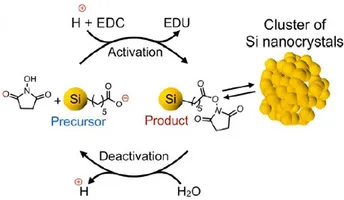IRTG 2022 "ATUMS" - Project 7.
Project 8. Sensing and delivery of therapeutics with a time switch by hybrid materials
TUM: Boekhoven, Rieger
UofA: Gibbs, Veinot
Students: Laura Tebcharani, Fabian Späth
Abstract:
In dissipative supramolecular materials, self-assembly of molecules or nanoparticles is driven by energy dissipating chemical reaction networks. In these networks, one chemical reaction activates a precursor into a product. The so-called activation reaction is driven by a chemical fuel and is irreversible. A second reaction occurs spontaneously, and reverts the product to the original precursor; we refer to this reaction as the deactivation. In its limited lifetime, the product can self-assemble into the supramolecular material. During the first ATUMS phase, we created supramolecular materials with a time switch based on the dissipative self-assembly of silicon nanocrystals (SiNCs), gold nanoparticles (Au-NPs) and small molecules. We also found that the SiNCs, in their unassembled state were taken up by cells with relative ease, but the cells did not take up the metastable micron-sized clusters. Based on the knowledge gained during the first funding period, we aim to explore further potential applications of these temporary assemblies of nanoparticles. Our primary objective is to apply the assemblies as temporary electronic circuits (mostly Au-NPs and Ag-NPs) (see Project 5). A second objective is to use the temporary SiNCs cluster as a sensing platform for DNA and also as a platform that delivers short interfering-RNA and messenger-RNA into cells with a delay.
